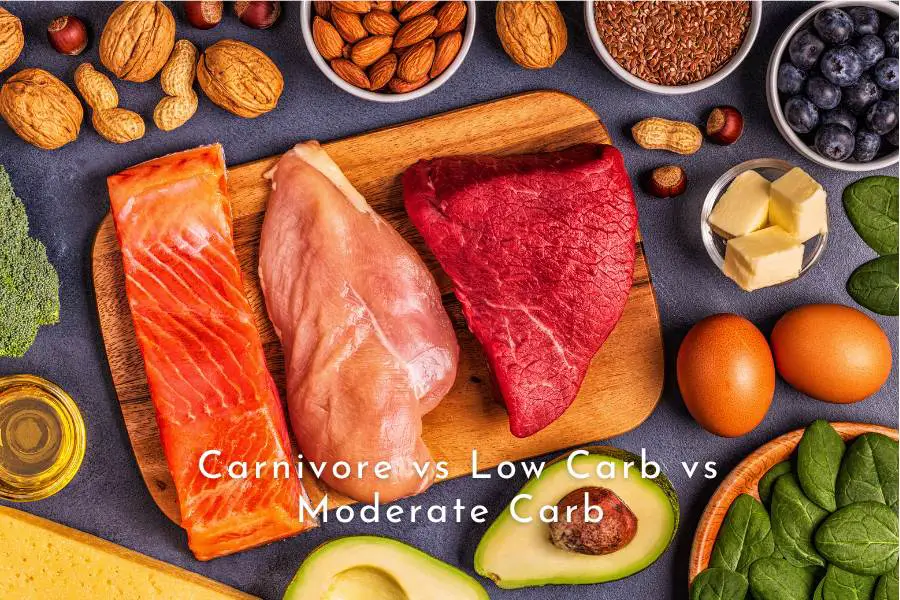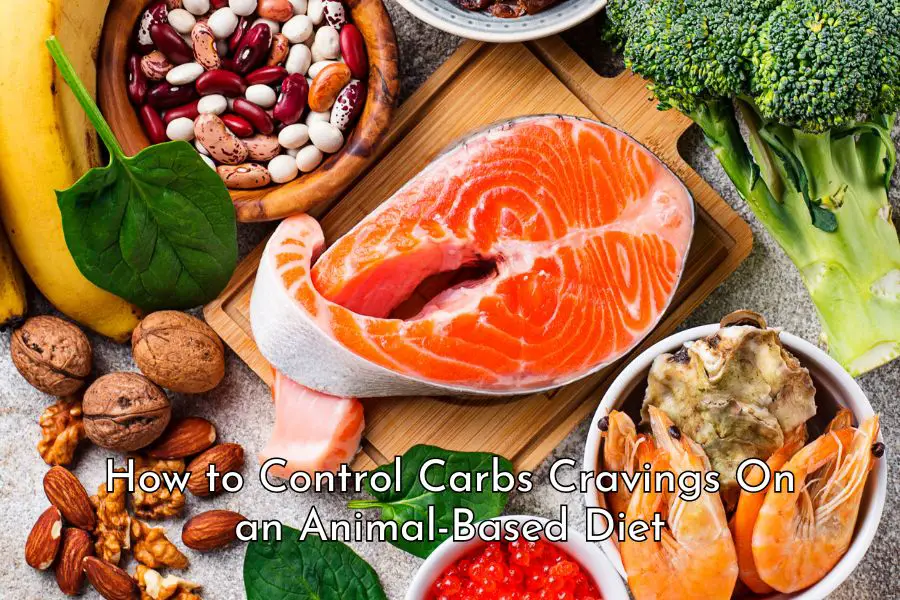Carnivore vs. low-carbs vs. moderate-carbs vs. high-carbs: Which diet is optimal for humans? This is the question we’ll explore in this post.
First let’s define what carnivore, low-carbs, moderate-carbs and high-carbs diets actually mean.
Carnivore diet
A carnivore diet is a diet that involves consuming exclusively animal-based foods (e.g. beef, pork, chicken, fish, and eggs) while excluding all plant-based foods.
There are many versions of the carnivore diet, for example, “rib-eye steak diet”, “beef, salt and water”, “steak and eggs”, “ruminant-based” or a broad version where all animal-sourced foods including dairy and honey are allowed.
Although there is limited scientific research on its long-term effects, the carnivore diet has become very popular in recent year because of its health benefits including weight loss, improved mental health and relief from chronic health conditions. [1, 2, 3, 4, 5, 6, 7, 8, 9, 10, 11]
There are people in the carnivore diet community (e.g. Dr. Anthony Chaffee, Dr. Ken Berry, and Dr. Robert Kiltz) who strongly believe that the carnivore diet is the optimal diet for humans because:
- Animal-based food can provide all nutrients that the human body needs
- Carbohydrates are not essential for human survival and humans can live without carbs; and
- There is nothing in plant-based food that you can’t get from meat but there are some essential nutrients that you can’t get from plant-based food
- Plant-based food comes with plant toxins that are detrimental for human health.
Low-carbs diet
A low-carbs diet is a diet that restricts the carbohydrate intake to a very low level and allowing for higher consumption of fats and proteins. [12]
On low-carbs diet, carbohydrate intake is typically kept at 20-50 grams a day. There is no specific requirement about animal or plant origins of food sources on this diet. The fat and protein intake can come from plant-based or animal-based food as long as your carb intake is kept below 50 grams a day so that your body will have to burn fat for fuel and stay in ketosis. [13]
Low-carbs diet has been found to be effective in helping people lose weight as well as having the potentials to treat a number of health conditions including diabetes, obesity, epilepsy, heart disease, liver disease, polycystic ovarian syndrome, Alzheimer disease, Parkinson disease, brain trauma, and cancer. [14, 15, 16, 17, 18, 19, 20, 21, 22, 23, 24, 25, 26, 27, 28, 29]
Low-carbs diet, however, has been criticized, for example, for its inability to produce long-term weight loss. While this criticism may have some validity, it is likely due to the fact that people find it difficult to adhere to this diet in the long run. In today’s food environment, staying low-carbs demands a certain level of discipline and willpower. Everywhere we turn, whether it’s grocery stores, fast-food chains, upscale restaurants, or in-flight meals, high-carbs foods abound. Carbohydrate-rich food tend to be highly addictive and present significant hurdles for practicing portion control or maintaining moderation.
Moderate-carbs diet
A moderate-carbs diet is a diet in which carbohydrate intake is anywhere between 50 to 220 grams a day, accounting for 44% or less of total daily calorie intake. [30]
Some people are of the view that a moderate-carbs diet is the optimal choice for humans. Dr. Paul Saladino, for instance, who previously followed a carnivore diet for several years, has transitioned to a moderate-carbs animal-based diet. He says that his health has seen significant improvements since reintroducing carbohydrates into his diet.
Dr. Saladino’s typical daily meals include the following: [31]
- Meat: 2 lbs of 80/20 ground beef and 2 raw egg yolks
- Organs: 0.5 oz liver, 2 oz of heart, 2 oz of testicle
- Fruit and honey (carbs): 3-5 tbsp honey per day (75g of carbs); papaya, 3 bananas, pineapple, 2 mangoes, 1 avocado (180 g carbs from fruit)
- Raw dairy: Few ounces of raw cheese, 10 ounces of homemade raw milk kefir.
Dr. Paul Saladino, however, is extremely physically active. He works out regularly as well as hikes, runs, surfs and practice martial arts.
High-carbs diet
A diet with a carbohydrate intake of 45% or higher is considered a high-carbs diet. For example, the Dietary Guidelines for Americans, 2020-2025 recommends Americans to get 45% to 65% of calories from carbohydrates which is extremely high in carbs. [32]
A high-carbs diet is the typical diet of most of the world’s population. Judging based on the current obesity epidemic we are facing, high-carbs diets don’t seem to be doing us any good. [33, 34]
Some may want to put the blame on our increasingly sedentary lifestyles. However, this has not been backed by evidence. People in the Western world, despite leading more sedentary lives, burn a similar amount of calories as the Hadza hunter-gatherers in Tanzania, known for their exceedingly active lifestyles. We may become less healthy due to our inactive lifestyle but diet remains the main reason why we become fatter and a lot sicker. [35, 36]
We gorge on calorie-dense, nutrient-void, and highly palatable food that has a low level of satiety, and as a result, we eat more, eat more often, and consume more calories than our bodies require. Consequently, it’s no wonder that we all become fatter and suffer from a wide-range of health issues
Which diet is optimal for humans?
High-carbs diet is unhealthy and not designed for humans
Of the four diets mentioned above, a high-carbs diet, in my opinion, is unhealthy and not designed for humans.
There is a substantial amount of evidence indicating that a high carb diet is detrimental for human health.
Since the 1970s, dietary guidelines have advised people, based on a flawed hypothesis, to reduce their saturated fat and cholesterol intake while increasing their carbohydrate consumption. This advice was rooted in the beliefs that “fat makes us fat” and “saturated fats raise cholesterol levels and increases the risk of heart disease.” However, it has come to light that the increase in carbohydrate consumption has coincided with a rise in diabetes and obesity rates in the United States. Furthermore, a high intake of carbohydrates has been linked to an increased risk of metabolic syndrome, cardiovascular disease, and overall mortality. [37, 38, 39, 40, 41, 42]
In addition, from an evolution perspective, a high-carbs diet is also not a diet that the human body is designed to eat. With high stomach acidity, simplified digestive system, higher body fat reserves, and metabolic adaptation to a high-fat diet, the human body has evolved and adapted to a heavily meat-based diet rather than an omnivore diet with a significant carbs component. [43, 44]
Carnivore diet is a reset diet suitable for healing chronic or serious health issues
The carnivore diet can be the optimal diet for people with chronic or serious health issues (e.g. obesity, diabetes, intestinal permeability, autoimmune conditions or cancer).
The carnivore diet can be viewed as a cleansing diet or a reset diet where you eliminate all plant based food and all plant toxins that come with it and eat only the most nutrient-dense and bioavailable food which is animal-based food. This provides an optimal condition for the body to fight diseases and heal from inside out.
There is a substantial body of evidence demonstrating the carnivore diet’s potential in helping people to improve or completely resolve their health issues by adhering to a strict carnivore diet. [45, 46, 47, 48, 49, 50, 51, 52, 53, 54, 55, 56, 57, 58, 59]
Low-carbs diet is sustainable and suitable for healthy people
In my view, a healthy low-carbs diet that comprises of mostly high quality animal-based food (e.g. beef, lamb, bison, goat, animal fat and organ meat) and some low-carbs fruits and vegetable can suit those who are in good health or face less urgent health issues.
Although you’d be consuming a bit of plant-based food and ingesting a small amount of plant anti-nutrients as a result, a low-carbs diet is less restrictive, easier to follow and more socially acceptable than a strict carnivore diet.
Moderate-carbs diet is suitable for healthy and physically active people
My personal view is that a moderate-carbs diet is not an optimal diet for humans but it can work for those who are healthy and physically active.
However, as mentioned above, biologically, the human body through millions of years of evolution, has become adapted to a heavily meat-based diet. The human body can very well handle carbohydrates to survive but it is not the optimal form of fuel. [60, 61]
You may feel fine on a moderate-carbs diet when you are young, healthy and doing a lot of exercises on a regular basis. However, as you age and your metabolic rate decreases, coupled with the wear and tear on your body, a moderate sugar intake and a moderate exposure to plant toxins may no longer be good idea.
I am aware that some people in the blue zones have thrived on high-carb diets, living to old age while seemingly free of many modern-day diseases. However, using this as a valid argument in favor of a high or moderate-carbs diet is not justified. While factors like a whole food diet, strong social networks, good environment and positive attitudes have contributed to their longevity, it’s worth considering the possibility that they might have lived even longer, perhaps up to 150 years or more, on a meat-based diet.
Other posts you might be interested in:
Is the Carnivore Diet Unhealthy Long-term?
What Is the Best Meat to Eat on the Carnivore Diet?
Best Sources of Carbohydrates On a Meat-Based Diet
How to Carnivore Diet While Traveling
Is Carnivore the Best Anti-Aging Diet Around?
10 Easy Carnivore Breakfast Ideas
11 Common Carnivore Diet Mistakes
Carnivore Diet for Beginners: 15 Tips for Success
Disclaimer: The information in this post is for reference purposes only and is not intended to constitute or replace professional medical advice. Please consult a qualified medical professional before making any changes to your diet or lifestyle. Please check out our disclaimer for more detail.





